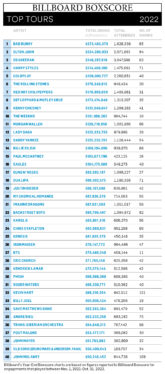With 2023 coming to a close, Billboard‘s year-end charts have finally touched down. But when were the year-end charts first put into practice, and how are they measured? The latest episode of Billboard Explains dives into the final charts of the calendar year, with some help from Billboard‘s Managing Director of Charts & Data Operations Keith Caulfield.
The annual year-end charts were launched back in the 1940s, and have become a staple of the magazine and website since. The end-of-year tallies measure metrics for each artist, title, label and music contributor from charts dated Nov, 19, 2022, to Oct 21, 2023. Technological advancements have allowed this process to change throughout the years, but according Caulfield, the process can be simplified as such: “You take all of the combined performance for all of the songs, artists, albums on a particular chart throughout that chart year, add them all together and then you get a bunch of numbers, and that, generally speaking, is what the year-end version of what that chart looks like.”
While the data-collection process is both rigorous and regimented, surprises sometimes happen. Dua Lipa’s “Levitating” was crowned the top song on the 2021 year-end Billboard Hot 100 chart, despite it never hitting No. 1. Though the track never crowned the Hot 100, the song’s many weeks on the tally (it never left the chart during the tracking period) allowed it to have more “points” than a song that, say, reached No. 1, but was at the summit for only a week.
“It’s not always about where you peaked at on the chart during the chart year, it’s your continued performance throughout the entire year that ultimately tells the story of where you end up on the year end chart,” Caulfield adds.
Visit Billboard‘s 2023 year-end charts here and watch the full episode above.
After the video, catch up on more Billboard Explains videos and learn about how Beyoncé arrived at Renaissance, the evolution of girl groups, BBMAs, NFTs, SXSW, the magic of boy bands, American Music Awards, the Billboard Latin Music Awards, the Hot 100 chart, how R&B/hip-hop became the biggest genre in the U.S., how festivals book their lineups, Billie Eilish’s formula for success, the history of rap battles, nonbinary awareness in music, the Billboard Music Awards, the Free Britney movement, rise of K-pop in the U.S., why Taylor Swift is re-recording her first six albums, the boom of hit all-female collaborations, how Grammy nominees and winners are chosen, why songwriters are selling their publishing catalogs, how the Super Bowl halftime show is booked and why Olivia Rodrigo’s “Drivers License” was able to shoot to No. 1 on the Hot 100.
https://www.billboard.com/music/music-news/billboard-explains-year-end-charts-1235562664/





